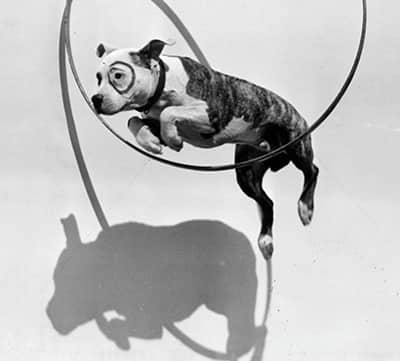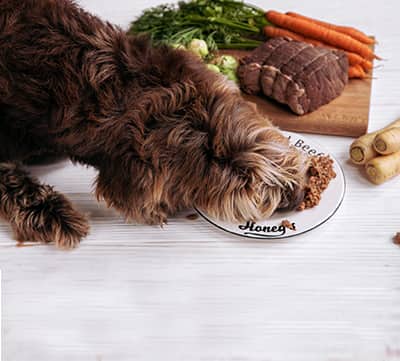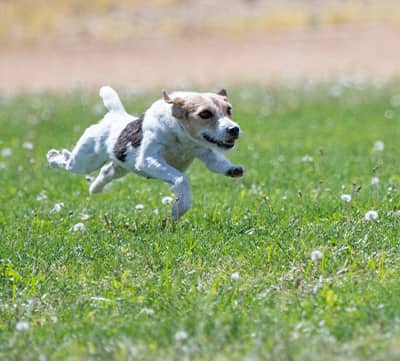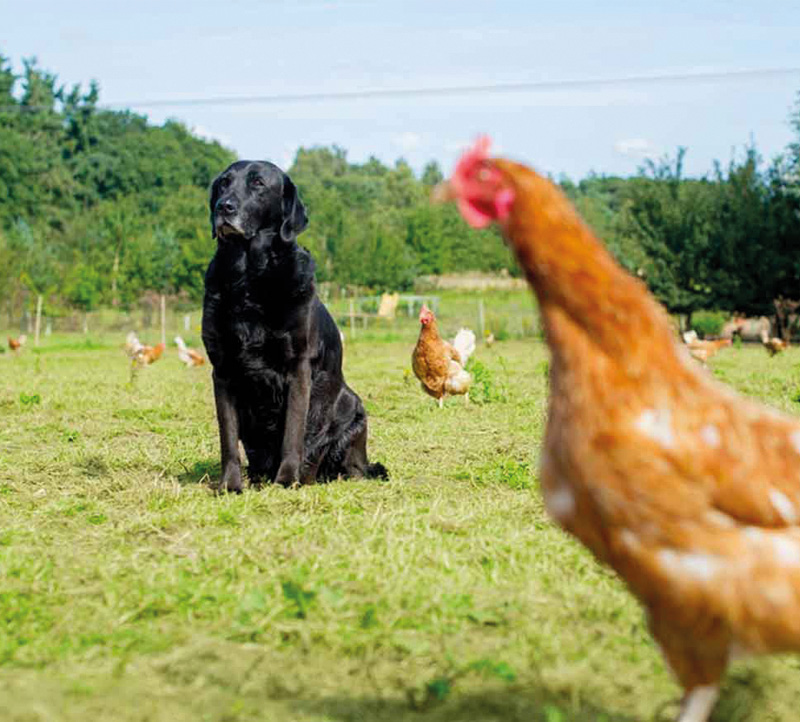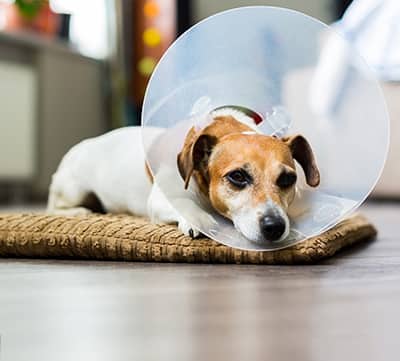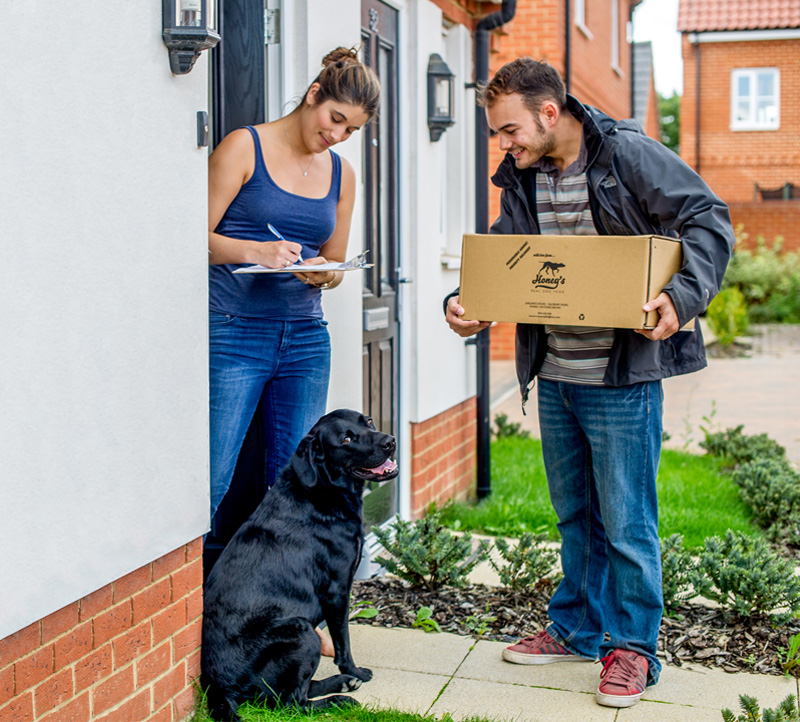Making the switch
The vast majority of dogs make the switch from processed food to raw food with no problem whatsoever and, generally speaking, the best approach is to fast your dog for a day and then to start them on their new, natural diet.
Troubleshooting tips
So, what problems might you encounter?
The most common issue when switching is that the dog turns its nose up at the raw food and refuses to eat it. If this happens, don’t worry! Remember, a dog can go up to a week without food and be none the worse for it. Give your dog a single chance to eat every 24 hours, and if he or she doesn’t pounce on it with enthusiasm the moment you put the bowl down, lift it straight back up and wait another day. It is not a good idea to ever leave food down for your dog. If you are too soft-hearted for this approach, try one of the switching options mentioned below.
(You may be interested to know that really intelligent dogs from loving homes are more likely to refuse raw food. Why? Their hunger for attention is greater than their hunger for food. Being smart, they realise that if they don’t eat you’ll make a fuss of them and this makes them happier than anything else can.)
Another problem can be regurgitation immediately after eating. This is almost certainly caused by a conditioned reflex. The dog’s stomach is expecting the normal food and has prepared the wrong kind of enzymes to digest it. When the new food turns up, the system rejects it. It is quite normal in nature for a dog to eat something, vomit it up and eat it again. It is, of course, up to you whether you allow this. But you shouldn’t panic. The solution to this sort of vomiting is, initially, patience and then to use one of the switching options mentioned below. Incidentally, dogs may also vomit bones because they aren’t used to eating them, and some people suspect that dogs vomit a meal that they really enjoyed eating so that they can have the pleasure of eating it again! If you have been raw feeding for a couple of weeks and the dog suddenly vomits, this may be an attempt to rid the body of toxins and is not unusual. Obviously, if your dog is vomiting frequently you should check with your vet that there isn’t any serious underlying health problem.
You shouldn’t panic, either, if your dog’s stools are runny. It is probably caused by the change in diet and will pass in a few days. It could also be the result of not enough bone in the diet as it is the bone that tends to make the stools firmer. The solution to runny stools is, initially, patience and then to use one of the switching options mentioned below or the remedies in health advice area of this website. You could also increase the bone element of the dog’s diet.
If your dog seems to have a problem with a particular ingredient try it for two or three days and then drop it and come back to it later.
Switching options
The easiest option is to fast the dog and just make the switch, as described above. The only reason to try another approach is if you encounter some problem making a direct switch. Here are the other options:
Tripe
Fast for a day and then make the switch immediately, but only feed your dog green tripe to begin with. Dogs find this incredibly easy to digest and it contains all the nutrients they need.
Mixing
Slowly start adding raw food to whatever it is you normally feed, increasing the amount every day until it is 100% raw after one or two weeks. This gives the dog’s stomach time to adjust to the change. If the dog is vomiting then, having checked it isn’t a medical issue, extend the period over which you make the switch. It doesn’t really matter if it takes a month or more.
Cooking
Take the raw food and cook it in a pan (not a microwave and not the bones). Every day cook it slightly less until it is raw. This gives the dog’s stomach time to adjust to the change from sterile, processed food.
Dogs and vegetables
Some dogs love vegetables; others don’t, and the ones who don’t may decline to eat their food for this reason. The solution? Give in to them! Remove vegetable from their diet completely and wait for a week or two before gradually reintroducing it. Another approach is to pour a little real gravy or break an egg over the food before serving it, as this will disguise the taste.
What to do if your dog becomes too thin
If your dog loses an unnatural amount of weight after switching to a natural diet, it will usually be because:
- The dog isn’t receiving enough food and/or the food being provided has too low a fat content. The solution is to increase the amount of food and/or the fat content.
- The dog’s stomach has not yet learnt to digest the raw food (bear in mind that it will need extra elasticity and muscle power). This is likely to be the problem if the dog is producing a large amount of waste matter. The solution is to try one of the switching techniques described elsewhere in this article.
Three things to watch out for
There are three possible issues that you should watch out for during the switchover period.
Bloat
One extremely rare condition to watch out for when switching your dog to a raw food diet is bloat. Bloat is caused by the stomach twisting so that food can’t pass between the oesophagus and the intestine. When this happens, the digestion process comes to a halt, the food will become subject to bacterial growth and gases will build up, forcing the stomach to look like a balloon. The risk of bloat is higher for large breeds and for dogs that have only been fed many small meals all their lives and then suddenly get to eat too much, with no rest afterwards. Also dogs that over-exercise after eating. If you think your dog may have bloat, contact your vet immediately.
Yellow bile
If your dog’s stool contains yellow bile for several days running after the introduction of raw food, it may indicate a pancreatic problem. This isn’t caused by raw food; rather, it is revealed by it. You should talk to your vet about this problem.
Itchy ‘hot’ spots
Itchy hot spots suggest that the food you are providing is a little too rich in one or more specific proteins. Vary the protein source (switch to different meats) or increase the fat and/or vegetable content.
The difference between runny stools and diarrhoea
There is a huge difference between soft or runny stools and diarrhoea.
It is normal, when switching diets, for dogs to experience soft or runny stools and it can occur if they aren’t eating enough bone. True diarrhoea is virtually liquid – like soup. A reliable remedy (apart from increasing the amount of bone you are feeding) is to give the dog slippery elm. Some people recommend mashed boiled sweet potato and leek to firm up stools. If you are worried, return the dog to the old diet and start again when things have settled down. At what point do you call in a vet? In the case of runny stools don’t wait more than a week. In the case of true diarrhoea you probably shouldn’t delay more than 24 hours.
Incidentally, true diarrhoea is not caused by raw food per se but will almost certainly be the result of either a parasite or gastrointestinal problem. If the latter, all that has happened is that the raw feeding has exposed the underlying problem.
When to seek experienced help
There are circumstances when a switch to raw feeding should only be undertaken with experienced guidance. Dogs that have recently undergone bowel surgery or chemotherapy or that have a compromised immune system can all benefit from a natural diet but may need a special diet. Also, pregnant dogs and new mums will have special nutritional needs. Please do contact us at Honey’s or consult a vet or other professional with raw feeding expertise.
For more information and advice please contact Honey’s – we’ll be happy to help even if you never, ever plan to become a customer.
Web: www.honeysrealdogfood.com
Email: info@ honeysrealdogfood.com
Telephone: 01672 620 260
